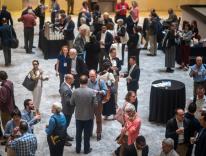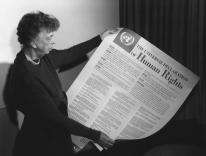
In the eyes of Rome, I was still in good or at least easily reparable standing in the Catholic Church until I married for the first time, in an Episcopal ceremony in 1980, and began the regular attendance at Episcopal services that I have continued to this day. In my own eyes, however, my exit began earlier and occurred in a gradual process that, simplifying, I can present in four steps.
The first step came in 1968 with Pope Paul VI’s publication of Humanae vitae, renewing the church’s absolute ban on artificial contraception. If I may risk a recent, very Catholic formulation, I found the pope’s position intrinsically disordered. I knew that a great deal of responsible Catholic thought favored the changes that the pope had declined to make. The encyclical had, accordingly, the early effect of weakening my lifelong allegiance to the church itself. It set the exit in motion.
At this point in my life, I was a Jesuit seminarian in doctoral studies. But I had begun to reflect with regard to my own decision (at eighteen) to become a Jesuit; it had been the Society of Jesus—its intellectualism, its internationalism, its esprit de corps, its glamor—that had attracted me more than the church to which, of course, the Society is dedicated. Did I not have the cart before the horse? This was a second step: a recognition that my passion for Catholicism per se had long been less than my formal vocation called for it to be.
In 1970, as I completed my doctorate, I took a position as assistant professor of theology at Loyola University of Chicago, now with my relationship to the Society of Jesus, the church, and the world of possible religious practice more in flux than ever. Early in the 1970s, I attended a debate in Chicago between the late John L. McKenzie, SJ, an eminent Bible scholar, and the late Charles Davis, an English theologian of Catholic background and training, who had recently departed the church. To the best of my recollection after nearly fifty years, Humanae vitae was the formal subject of the debate, but the church itself was powerfully the background subject.
In the course of the debate, Davis posed a question that I then found and still find extremely clarifying. What, he asked, is available in Roman Catholicism that is available in no other form of Christianity? Would it be scholastic theology? Marian devotion? Eucharistic piety? A sense of universal mission? In every case that he could adduce, and he adduced at least a representative sample, the named item was available somewhere else in greater Christianity. What was uniquely to be had in Roman Catholicism, he concluded, was indeed romanità. It was the distinctive authority structure of the Roman church.
Was it he who then said, or I who then inferred, that just this structure had been exposed as inhuman or, to repeat the phrase above, intrinsically disordered in Humanae vitae? Whether any such judgment was to be rendered or not, Davis’s way of engaging the question made leaving the church seem far less grave and dramatic a matter than it had so long seemed within a religious taxonomy that divided the world into Catholics and non-Catholics, erasing all distinctions within the immensity of the latter group. In particular, it diminished the gravity of moving from one Christian communion to another.
During Vatican II, we Catholics grew used to the phrase “separated brethren” as a group designation for non-Catholic Christians. Davis led me to see us all, including the Catholics, as a single large band of mutually separated brethren. And the consequence of this change of perspective was that leaving the Roman Catholic Church for, say, the Episcopal or the Russian Orthodox Church was rather like leaving the Jesuits for the diocesan clergy or for the Benedictines. We had all once been a single church. We all still entertained an eschatological hope to be one again, recalling the ut sint unum of John 17:22–23: “The glory that you have given me,” Christ says to his apostles at the Last Supper,
…I have given them, so that they may be one, as we are one, I in them and you in me, that they may become completely one, so that the world may know that you have sent me and have loved them even as you have loved me.
Against this scriptural backdrop, leaving one Christian communion for another I saw as a proleptic act, a declaration of membership in the larger, glorious communion of ultimate reconciliation that lies over the horizon. Rather than a simple act of leaving, then, it was a kind of joining. This was a third step.
But there was a significant fourth step still ahead. My mental relocation from Roman Catholicism to Greater Christianity did not either logically or actually entail my becoming a practicing Episcopalian. I was then fresh from a doctoral program in Old Testament Studies that, in effect, was a program in comparative Semitic religion. I easily grasped the utility of understanding ancient Israelite religion by broadening the context in which it was considered, but why stop there? The seventies were a decade of lively American interest in Buddhism and Hinduism. In various ways, I had long been drawn to Judaism. In the “Concluding Unscholarly Postscript” to my introduction to The Norton Anthology of World Religions, I sketch how, in the course of the seventies, I took a further step and embraced despair (the phrase now makes me smile) as counseled by Bertrand Russell in “Why I Am Not a Christian” and then, at length (another smile here), tired of my own despair and ditched it. Neo-Buddhism, in a wholly ahistorical American configuration, beckoned for a while. I began a meditation practice under the direction of a convert to Hinduism that I still turn to now and again. In short, I passed the better part of a decade in existential exploration and experimentation, leading indirectly to a more academic kind of comparative religious exploration later.
After four years at Loyola and a fifth at the University of Montana, I left academe—forever, as I thought at the time—and commenced, in New York, the rewarding career in book publishing and journalism that filled the prime of my professional life. It was in New York that I first began occasionally attending Episcopal services, drawn by the superior music, the shapely liturgy, and a different sense of deep rootage in a mature tradition. I come from a Northern Irish family, however, and one of my cousins was imprisoned and brutalized only a generation ago by the British during the Troubles. Briefly, the thought of joining the English church seemed an unconscionable betrayal. Yet the Irish cousins themselves provided the corrective to that. Intermarried, they are quite averse to any Brit-bashing by visiting Yanks. The Irish of the Republic, thanks to their success in overleaping Britain to join the European Union, seem happy to be quite done with the age-old Hibernian ressentiment. So I got over it too and found, as Protestants like to say, a “church home.”
I am the more easily at home in the Episcopal Church because it is not the Anglican church and has not been since the American Revolution. The British monarch is still the titular head of the Anglican Church. The Episcopal Church, by sharp contrast, is headed by an elected presiding bishop, a constitutional arrangement that rather obviously reflects the American Constitution. Episcopalians and Anglicans together belong to a loose association, not a church, called the “Anglican Communion.” But such considerations as these were really minor matters that arose and were set aside well after I had concluded that, after all, I did want to practice a religion and that for historical, psychological, and aesthetic reasons, I would be better off as an Episcopal Christian with whatever mental reservations and extra-Christian inclinations than as an awkward and out-of-step Buddhist with an unshakably Christian cast of mind. So, then, this was the fourth step, consummated at the time of my first marriage. (Yes, there has since been a second marriage.)
Charles Davis returned to the Roman Catholic fold shortly before his death in 1999, but I do not anticipate that I will do so. My wife and I have purchased a pair of niches in the columbarium at the back of the Church of the Messiah in Santa Ana, California. Davis’s judgment that romanità is defining where the Church of Rome is concerned, as well as his judgment about the human harm done by the pyramidal Roman authority structure, has since been painfully confirmed by the trauma of the sex-abuse scandal. More poignantly, somehow, it has been confirmed again for me as Pope Francis, after a few hopeful early signs, has finally failed even to allow divorced and remarried Catholics to receive Communion. As for the contraceptive ban that has opened such a chasm of alienation between the laity and the clergy within the church (and between the church and the nation), any adjustment seems as remote a possibility now as ever, half a century after Humanae vitae. I look on all this with sorrow, knowing that so many good Catholic friends would warmly welcome the changes that will never come. I still care about what happens to the Roman Catholic church, as all Christians should within the one mystical body of Christ, but for years now I have been relieved to do this from what has proven to be, for me, a saving, widening distance.
Please email comments to [email protected] and join the conversation on our Facebook page.
Previous Story
Why I Came...and Will Stay
Next Story
Why I’ll Stay, Why I Left


